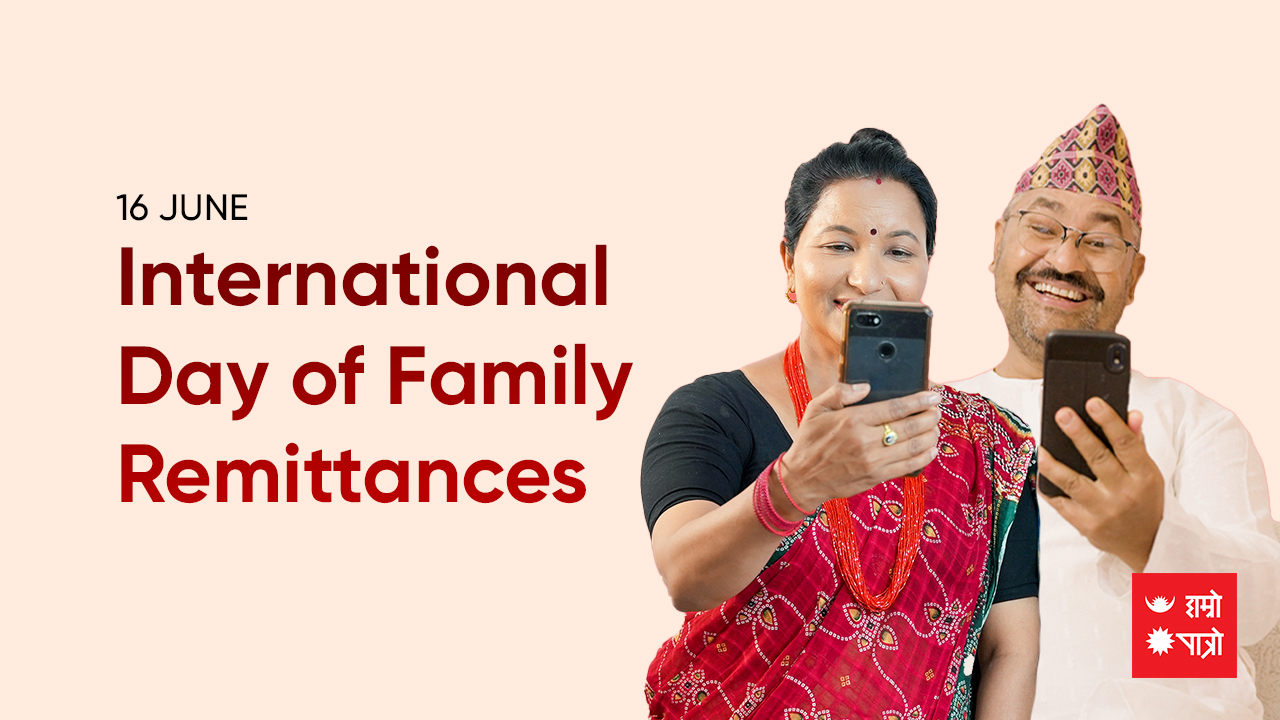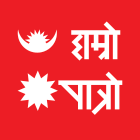Upcomming Events
-
6JesthaMohini Ekadashi Vrata today
-
7JesthaSom Pradosh Vrata tomorrow
-
8JesthaNrisingha Jayanti 2 days remaning
-
9Jestha
-
10Jestha
-
15JesthaNational Republic Day 9 days remaning
-
17JesthaGorakhkali Puja 11 days remaning
-
18JesthaWorld No Tobacco Day 12 days remaning
-
19JesthaGlobal Day Of Parents 13 days remaning
-
20JesthaApara Ekadashi Vrata (Smarta)/Chittadhar Hridaya Janma Jayanti 14 days remaning
-
21Jestha
-
22Jestha
-
23JesthaSithi Cha: Hre/World Environment Day 17 days remaning
-
24JesthaBata sabitri Vrata/Shani Jayanti Vrata 18 days remaning
-
25JesthaGosaikunda Snan Aarambha/Dasahara Snan Arambha 19 days remaning
-
27JesthaRashtriya Krishak Diwas 21 days remaning
-
30JesthaSithi Nakha/World Day Against Child Labour 24 days remaning
-
32JesthaGorakhkali Puja/World Blood Donor Day 26 days remaning
-
1AashadhaMithun Sankranti/World Elder Abuse Awareness Day 27 days remaning
-
2Aashadha
-
3Aashadha
-
4AashadhaNirjala Ekadashi Vrata (Vaisnav) 30 days remaning
-
5Aashadha
-
6AashadhaWorld Refugee Day 32 days remaning
-
7AashadhaPoornima Vrata/World Yoga Day/ Music Day 33 days remaning
-
8AashadhaJya: Punhi/Kabir Jayanti 34 days remaning
-
9AashadhaInternational Widows Day 35 days remaning
-
11AashadhaMangal Chauthi Vrata/Bhumi Pooja 37 days remaning
-
12AashadhaInternational Day against Drug Abuse and Illicit Trafficking 38 days remaning
-
15AashadhaDahi chiura Khane Din/ Rashtriya Dhan Diwas/Gorakhkali Puja 41 days remaning
-
17AashadhaInternational Cooperative Day 43 days remaning
-
18AashadhaYogini Ekadashi Vrata/World Sports Journalist Day 44 days remaning
-
19AashadhaPradosh Vrata 45 days remaning
-
22AashadhaWorld Population Day 48 days remaning
-
29AashadhaBhanu Jayanti/Surya Pooja 55 days remaning
-
30AashadhaGorakhkali Puja 56 days remaning
-
31AashadhaWorld Youth Skill Day 57 days remaning
-
1Shrawan
-
2ShrawanHarishayani Ekadashi Vrata/Chaturmaas Wrata Aarambha 59 days remaning
-
3ShrawanPradosh Vrata 60 days remaning
Jyotish
-
Jyotish Narayan Prasad Gautamगुरुकुल शिक्षा प्रणालीबाट ज्�...
-
Jyotish Damodar Kaushikज्योतिष र व्याकरण विषयमा आचार�...
-
Jyotish Vaman Sapkotaशिक्षा - व्याकरणाचार्य, पौरोही...
-
Jyotish Dr. Janak Bhattaविगत ३५ वर्षदेखि कुण्डली निर्�...
-
Jyotish Damodar Poudelनेपाल संस्कृत विश्व बिद्यालय�...
-
Jyotish Mohan Ghimireसम्पुर्णानन्द संस्कृत विश्वव...
-
Jyotish Dipendra Khatiwadaसम्पुर्णानन्द संस्कृत बिश्वब...
-
Jyotish Mukunda Sharmaस्वाध्याय, सत्सङ्ग र सदाचारजस�...
-
Jyotish Deepak Prasad Kafleसम्पूर्णानन्द संस्कृत विश्वव...
-
Hamro Patro JyotishI am test jyotish please donot call.
-
Jyotish Khageshwor Subediगुरुकुल पद्दति बाट ज्योतिषीय �...
-
Jyotish Ghanashyam Pokharelनेपाल संस्कृत विश्वविद्यालयब...
-
Acharya Choodamani Pathakसम्पूर्णानन्दसंस्कृत विश्वव�...
-
Jyotish Smarika Acharyaबाल्मीकि बिद्यापिठ बाट ज्योत�...
-
Jyotish Narayan Prasad Dulalसम्पूर्णानन्द संस्कृत विश्वव...
-
Jyotish hamropatrojyotish of nepal
-
Jyotish Purushottam Ghimireनेपाल संस्कृत विश्वविद्यालय, �...
-
Jyotish Khagendra Subediसम्पूर्णानंद संस्कृत विश्ववि...
जेठ शुक्ल दशमी
Gangadasahara Vrata/Gosaikunda Snan Samapti/International Day of Family Remittances/International Father's Day

Importance of Ganga Dasahara
The importance of Jestha Shukla Pratipada tithi is very high. On this tithi, in the Vedic period, Bhagirathi brought Ganga to earth. Before this, the holy Ganga used to flow only in the heavens, but after this, it is believed that the descent of the Ganga took place in the earth.
What are done today?
Thus, on the date of the arrival of Ganga, people plant basil seeds and start a series of holy baths. This series of baths is called Dashara bath. These series of holy baths, which last for 10 days from Pratipada to Ekadashi, are believed to destroy a kind of sin every day. This is called the Dasahara bath because one gets rid of ten types of sins in ten days.
The sin of taking an object without being allowed to do so, committing the crime, committing adultery, speaking harsh words, telling lies, slandering, blaspheming, wanting to usurp the property of others, wanting to harm others, and being stubborn without any reason. There is a classical belief that if you go to Triveni (A combination of three rivers) or any river and take a bath, your sins will be destroyed.
Gosainkunda Bathing ritual
ॐ अस्य श्री भगवान नीलकंठ सदा-शिव-स्तोत्र मंत्रस्य श्री ब्रह्मा ऋषिः, अनुष्ठुप छन्दः,
श्री नीलकंठ सदाशिवो देवता, ब्रह्म बीजं, पार्वती शक्तिः, मम समस्त पाप क्षयार्थंक्षे म-स्थै-आर्यु-आरोग्य-अभिवृद्धयर्थं
मोक्षादि-चतुर्वर्ग-साधनार्थं च श्री नीलकंठ-सदाशिव-प्रसाद-सिद्धयर्थे जपे विनियोगः।
For The Neelakanta Sadhashiva Mantra Prayer, the Sage Is Brahma, the Meter Is Anushtup,
The God Addressed Is Neelakanta Sadhashiva, the Seed Is Brahma, the Power Is Parvati
And For Complete Destruction of All My Sins, For Enhancement of Pleasant Life and Stability of Life. Span And Health, For Getting The Four Things Dharma, Prosperity, Desires And Salvation, I Am Chanting This Mantra.
Neelkantha and the formation of Gosaikunda
Neelkantha, the one who has a blue throat, I begin from here today, and this is a splendid story. Lord Shiva swallowed the Halahal poison which appeared during the Samudra Manthan, Nilkantha in the desperation of the poison went straight to holy Gosaikunda Lake in the mountains and slept there under the cold water.
At an altitude over 4380 meters above sea level, Gosainkunda (Gosain means Lord and Kunda is a holy pond) is believed to have been created by the Trisul of Lord Shiva.
To get the elixir from the ocean, the Samundra Manthan or the churning process was on its go, a lot of things came out of the ocean which included gold, silvers, gems, goddesses Luxmi, Dhawantari, and many more. Among all those, deadly Halahal poison was one among them, this was so deadly that it perished everyone who came into contact with it. Gods and demons were asphyxiated because of the effect, sooner Bramhma and Vishnu asked for help from Lord Shiva.
Upon the consumption of this poison, Lord Shiva started turning blue, alarmed by the rapidly spreading poison into Lord Shiva's body Goddesses Parwati entered Shiva's throat in the form of Mahavidya and controlled the spreading of poison confining its effect only to his throat.Hence, Neelkantha connotes that we need to control all our negative thoughts and keep working towards achieving our goals.
Gosainkunda, a place that must be visited once in a lifetime, has a tradition of taking a holy dip every year with thousands of devotees, this starts from today. The number of devotees bathing in the holy shrine of Rasuwa, Gosainkunda, concludes today.
There is a religious belief that bathing, giving alms, and offering Tarpan in Gosainkunda will assist ancestors to liberate and achieve salvation. These holy dips will also assist to get rid of the sins committed for life and fulfill their desires.
International Day of Family Remittances
Background:
The International Day of Family Remittances (IDFR) is a universally-recognized observance adopted by the United Nations General Assembly and celebrated every year on 16 June. The Day recognizes the contribution of over 200 million migrants to improve the lives of their 800 million family members back home, and to create a future of hope for their children. Half of these flows go to rural areas, where poverty and hunger are concentrated, and where remittances count the most.
Through this observance, the United Nations aims to bring greater awareness of the impact that these contributions have on millions of households, but also on communities, countries, and entire regions. The Day also calls upon governments, private sector entities, as well as the civil society, to find ways that can maximize the impact of remittances through individual, and/or collective actions.
According to Nepal Rastra Bank, the country’s central bank, the number of Nepali workers taking approval for foreign employment increased 57.3 percent to 314,767 in the review period. The number of Nepali workers [renew entry] taking approval for foreign employment increased 10 percent to 167,708 in the review period.
Hamro Remit
With our zeal and our pursuit to simplify the remittance transaction in Nepali, we've also started the "Hamro Remit" service, and today, Hamro Patro would like to thank all users and stakeholders out there for having trust in us and being a part of the "Hamro Remit" service. You can also give it a try, "Hamro Remit" is the best way to send money to Nepal.
This day is extremely important for the Nepali environment, which is based on remittances as an economy. Respect remittances and respect the family members who send remittances.
International Father's Day
Background:
World Father's Day, also known as International Fathers Day, is a day dedicated to celebrating and honoring fathers and father figures worldwide. It is a time to recognize and appreciate the contributions, sacrifices, and love that fathers provide to their families and communities.
While Father's Day is celebrated on different dates in various countries, the concept of a global Fathers Day aims to promote the importance of fatherhood and the positive impact fathers have on their children's lives.
World Fathers Day is typically celebrated on the third Sunday in June, following the tradition established in the United States. However, some countries may have their own designated dates for Fathers Day. For example, in Australia, Fathers Day is celebrated on the first Sunday in September.
On this day, children and family members often express their gratitude and love for their fathers through various gestures, such as giving cards, gifts, or spending quality time together. It is a time for families to come together and show appreciation for the paternal figures in their lives.
World Fathers Day serves as a reminder of the vital role fathers play in the upbringing and development of their children. It promotes the importance of strong and nurturing father-child relationships and encourages society to recognize and support fathers in their roles as caregivers, mentors, and role models.
Please note that the celebration and customs of Fathers Day may vary across cultures and countries.
-Suyog Dhakal
Upcomming Events
-
6JesthaMohini Ekadashi Vrata today
-
7JesthaSom Pradosh Vrata tomorrow
-
8JesthaNrisingha Jayanti 2 days remaning
-
9Jestha
-
10Jestha
-
15JesthaNational Republic Day 9 days remaning
-
17JesthaGorakhkali Puja 11 days remaning
-
18JesthaWorld No Tobacco Day 12 days remaning
-
19JesthaGlobal Day Of Parents 13 days remaning
-
20JesthaApara Ekadashi Vrata (Smarta)/Chittadhar Hridaya Janma Jayanti 14 days remaning
-
21Jestha
-
22Jestha
-
23JesthaSithi Cha: Hre/World Environment Day 17 days remaning
-
24JesthaBata sabitri Vrata/Shani Jayanti Vrata 18 days remaning
-
25JesthaGosaikunda Snan Aarambha/Dasahara Snan Arambha 19 days remaning
-
27JesthaRashtriya Krishak Diwas 21 days remaning
-
30JesthaSithi Nakha/World Day Against Child Labour 24 days remaning
-
32JesthaGorakhkali Puja/World Blood Donor Day 26 days remaning
-
1AashadhaMithun Sankranti/World Elder Abuse Awareness Day 27 days remaning
-
2Aashadha
-
3Aashadha
-
4AashadhaNirjala Ekadashi Vrata (Vaisnav) 30 days remaning
-
5Aashadha
-
6AashadhaWorld Refugee Day 32 days remaning
-
7AashadhaPoornima Vrata/World Yoga Day/ Music Day 33 days remaning
-
8AashadhaJya: Punhi/Kabir Jayanti 34 days remaning
-
9AashadhaInternational Widows Day 35 days remaning
-
11AashadhaMangal Chauthi Vrata/Bhumi Pooja 37 days remaning
-
12AashadhaInternational Day against Drug Abuse and Illicit Trafficking 38 days remaning
-
15AashadhaDahi chiura Khane Din/ Rashtriya Dhan Diwas/Gorakhkali Puja 41 days remaning
-
17AashadhaInternational Cooperative Day 43 days remaning
-
18AashadhaYogini Ekadashi Vrata/World Sports Journalist Day 44 days remaning
-
19AashadhaPradosh Vrata 45 days remaning
-
22AashadhaWorld Population Day 48 days remaning
-
29AashadhaBhanu Jayanti/Surya Pooja 55 days remaning
-
30AashadhaGorakhkali Puja 56 days remaning
-
31AashadhaWorld Youth Skill Day 57 days remaning
-
1Shrawan
-
2ShrawanHarishayani Ekadashi Vrata/Chaturmaas Wrata Aarambha 59 days remaning
-
3ShrawanPradosh Vrata 60 days remaning
Jyotish
-
Jyotish Narayan Prasad Gautamगुरुकुल शिक्षा प्रणालीबाट ज्�...
-
Jyotish Damodar Kaushikज्योतिष र व्याकरण विषयमा आचार�...
-
Jyotish Vaman Sapkotaशिक्षा - व्याकरणाचार्य, पौरोही...
-
Jyotish Dr. Janak Bhattaविगत ३५ वर्षदेखि कुण्डली निर्�...
-
Jyotish Damodar Poudelनेपाल संस्कृत विश्व बिद्यालय�...
-
Jyotish Mohan Ghimireसम्पुर्णानन्द संस्कृत विश्वव...
-
Jyotish Dipendra Khatiwadaसम्पुर्णानन्द संस्कृत बिश्वब...
-
Jyotish Mukunda Sharmaस्वाध्याय, सत्सङ्ग र सदाचारजस�...
-
Jyotish Deepak Prasad Kafleसम्पूर्णानन्द संस्कृत विश्वव...
-
Hamro Patro JyotishI am test jyotish please donot call.
-
Jyotish Khageshwor Subediगुरुकुल पद्दति बाट ज्योतिषीय �...
-
Jyotish Ghanashyam Pokharelनेपाल संस्कृत विश्वविद्यालयब...
-
Acharya Choodamani Pathakसम्पूर्णानन्दसंस्कृत विश्वव�...
-
Jyotish Smarika Acharyaबाल्मीकि बिद्यापिठ बाट ज्योत�...
-
Jyotish Narayan Prasad Dulalसम्पूर्णानन्द संस्कृत विश्वव...
-
Jyotish hamropatrojyotish of nepal
-
Jyotish Purushottam Ghimireनेपाल संस्कृत विश्वविद्यालय, �...
-
Jyotish Khagendra Subediसम्पूर्णानंद संस्कृत विश्ववि...
Liked by:




















 Mesh
Mesh Brish
Brish Mithun
Mithun Karkat
Karkat  Singha
Singha  Kanya
Kanya Tula
Tula Brischik
Brischik Dhanu
Dhanu  Makar
Makar  Kumbha
Kumbha Meen
Meen